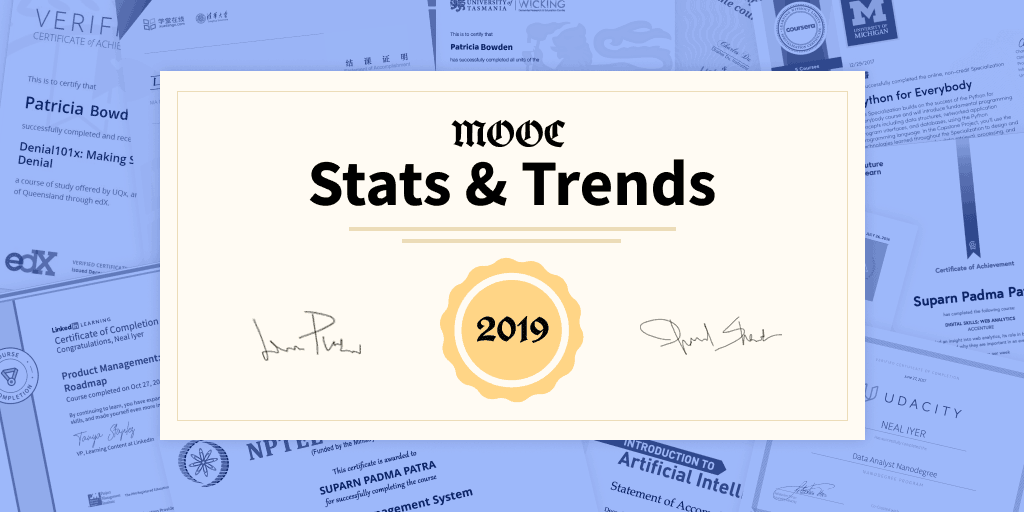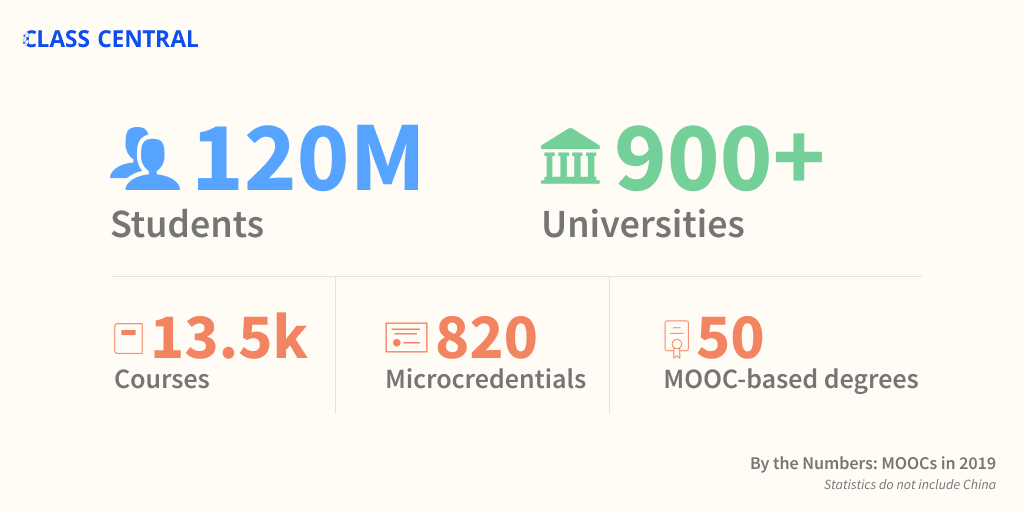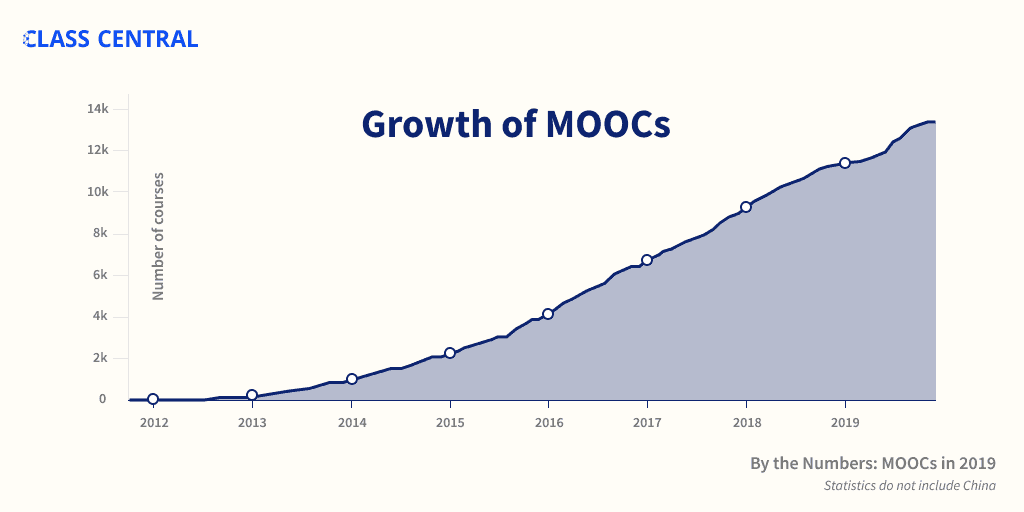Online Degrees Slowdown: A Review of MOOC Stats and Trends in 2019
In 2019, the MOOC-degree hype seems to have subsided: only 11 online degrees were announced.

Last year, MOOC providers announced around 30 online degrees. These announcements and the resources being spent by MOOC providers and universities alike gave me a feeling of déjà vu: it reminded me of the 2012 MOOC hype.
That is why I called the rise of online degrees the second wave of MOOC hype and 2018, the year of MOOC-based degrees.
| 2017 | 2018 | 2019 | |
| Coursera | 4 | 11 | 16 |
| edX | 1 | 9 | 10 |
| FutureLearn | 4 | 18 | 23 |
| Udacity | 1 | 1 | 1 |
| Total | 10 | 39 (+29) | 50 (+11) |
But in 2019, the hype seems to have subsided: only 11 online degrees were announced this year. The total number of MOOC-based degrees has now grown to 50.
It might be the case that the new degrees are not receiving the enrollments expected by MOOC providers. Or MOOC providers got into an arms race of sorts and rushed to announce these degrees in 2018. Many won’t even start accepting applications for a long time.
Coursera and FutureLearn both raised significant capital this year, incidentally from the same investor. Their break into the lucrative online degree market likely helped them obtain new funding. Coursera achieved the coveted unicorn status after their Series E funding round of $103M. And with a £50M investment, SEEK Group became a joint owner of FutureLearn with The Open University.
Besides these funding rounds, MOOC providers had a mostly uneventful year. As in previous years, Udacity implemented numerous policy changes. It also appointed a new CEO, while EdX acquired a co-CEO. Another late trend that we noticed is annual catalog subscription. Early this year, FutureLearn announced FutureLearn Unlimited ($249/year), and Coursera is also currently testing out Coursera Plus ($399-$499/year).
Here’s how the top-5 MOOC providers currently look in terms of users and offerings:
| Learners | Courses | Microcredentials | Degrees | |
| Coursera | 45 million | 3,800 | 420 | 16 |
| edX | 24 million | 2,640 | 292 | 10 |
| Udacity | 11.5 million | 200 | 40 | 1 |
| FutureLearn 2,4 | 10 million | 880 | 49 | 23 |
| Swayam 2,3 | 10 million | 1,000 | 0 | 0 |
You can read about how the year went for the top four companies in Class Central’s 2019 Year in Review articles:
- Coursera’s 2019:Year in Review
- edX’s 2019: Year in Review
- FutureLearn’s 2019: Year in Review
- Udacity’s 2019: Year in Review
By The Numbers

Now in its eighth year, the modern MOOC movement has reached 120 million learners, excluding China1.
In 2019, Coursera and edX added more learners than in 2018. This year we started tracking India’s official MOOC platform, Swayam.
We saw over 450 universities announce 2,500+ courses in 2019. This takes the total number of MOOCs launched by the end of 2019 to 13,500.

New university partnerships are rare, but we found 80+ universities offering courses on multiple platforms. Some like the University of Michigan have MOOCs on three different platforms.
Fundamental to our @UMichiganAI strategy is the ability to experiment widely and partner with orgs that share our mission to transform access and reshape the future of learning. We are deeply committed to the discovery of what’s next and steadfast about sharing what we learn. https://t.co/zwrSAnwQRm
— James DeVaney (@DeVaneyGoBlue) October 2, 2019
Microcredentials
The total number of MOOC-based microcredentials has now passed 800. In 2019, more than 170 new microcredentials of 10 different types were launched. In 2018, only 120 microcredentials were added.
If you’d like a complete breakdown of these microcredentials as well as other detailed numbers, head to By the Numbers: MOOCs in 2019. If you’d like to dive into the history of the MOOC space, head to our previous end-of-year articles:
- MOOC Stats and Trends 2018: The Year of MOOC-Based Degrees
- MOOC Stats and Trends 2017: A Product at Every Price
- MOOC Stats and Trends 2016: Monetization over Massiveness
[1] We decided to leave China out of our analysis this year because, as we learned more about Chinese online education, we realized that the metrics we’d like to present are: (1) sometimes unavailable, (2) sometimes available but impossible to validate to the extent we’d like, (3) sometimes reflect a view too narrow to adequately capture the overall state of MOOCs in China.
[2] For platforms with session based courses, we included the total number of courses offered in 2019.
[3] This is the first year that Swayam is included in Class Central’s analysis. This year, NPTEL and Swayam were merged, which is one of the reasons behind the rapid growth of the Indian MOOC provider.
[4] Graduate/Postgraduate Certificates and Diplomas are listed under microcredentials, instead of under degrees.
This article is just one of our 2019 MOOC Roundup Series. Find the whole series here. You’ll discover everything about MOOCs in 2019 — from the most popular classes, to overviews of MOOC platforms developments, to looking at the future of MOOCs.







BW
“the lucrative online degree market”
How do we know that this market is actually lucrative?
Cece
The MOOC evolution has changed my life for the better. It’s truly made me fairly healthy, wealthy and wise and in only 2 years. I can not thank the creators and contributing universities and proffessors enough.
The happiness and learning courses need to be made into children learning books.
Maqsood Memon
The MOOC has now growing more popularity from the year 2024 as the Universities and Colleges in India have implemented NEP 2020 and in which it is compulsory to opt 2 credit course of MOOC